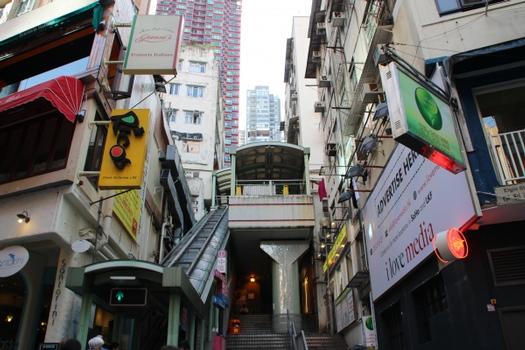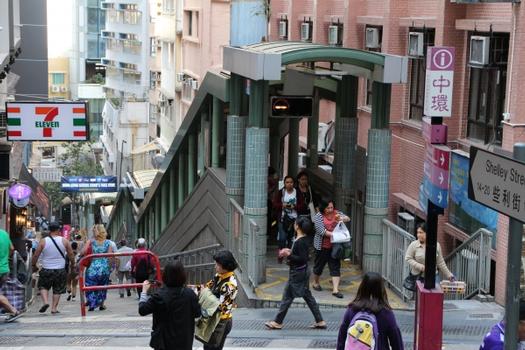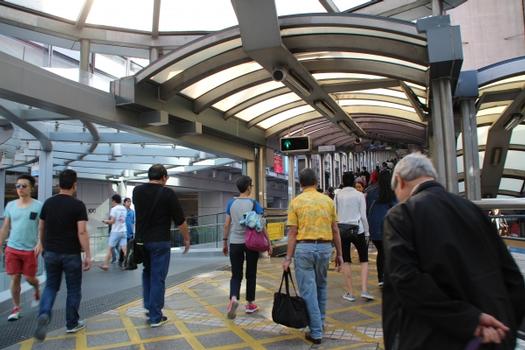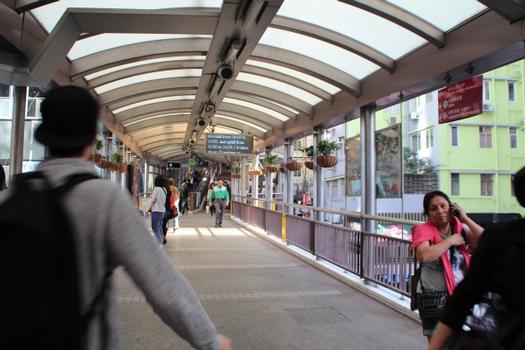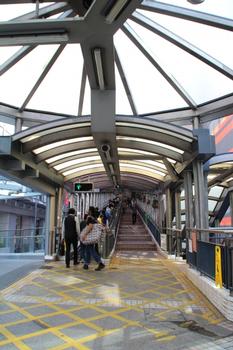General Information
| Completion: | 15 October 1993 |
|---|---|
| Status: | in use |
Project Type
| Function / usage: |
Escalator system |
|---|
Location
| Location: |
Central, Central and Western, Hong Kong, China |
|---|---|
| Coordinates: | 22° 17' 1.32" N 114° 9' 18" E |
Technical Information
Dimensions
| total length | ca. 800 m | |
| height difference | ca. 135 m |
Excerpt from Wikipedia
The Central–Mid-Levels escalator and walkway system in Hong Kong is the longest outdoor covered escalator system in the world. The system covers over 800 m (2,600 ft) in distance and traverses an elevation of over 135 m (443 ft) from bottom to top. It opened in 1993 to provide an improved link between the Central and Mid-Levels districts on Hong Kong Island.
The top stage of the escalator system between Robinson Road and Conduit Road has been replaced, and went operational on 11 July 2018. In early 2019, three refurbished escalators between Mosque Street and Robinson Road went operational. In June 2019, two replaced escalators between Caine Road and Elgin Street opened to the public. The escalator between Gage Street and Wellington Street is currently under refurbishment.
Apart from serving as a mode of transportation, the system is also a tourist attraction and is lined with restaurants, bars, and shops.
History
Origins
The project was first publicly mooted in the early 1980s. The government found that much of the east-west traffic in the area arose from north-south travel demand, as the steep topography did not allow for major roads to be built straight up the hill. There was talk of linking Central and Mid-Levels with escalators, a monorail, or a cable-car system.
In late 1982, private consultants Peter Y.S. Pun and Associates and MVA Asia were commissioned to investigate traffic improvement measures in Central. In their report entitled A Study of the Transport Requirements of the Mid-Levels and Central District, the consultant recommended, inter alia, to build an "escalator assisted pedestrian route" linking Mid-Levels to the existing Central Elevated Walkway system and a new bus terminus that they proposed should be built on the site of the Central Market. This proposal was well-received by Mid-Levels residents.
Construction and opening
The Highways Department commissioned Maunsell Consultants Asia to draw up a detailed design for the system. The Executive Council approved the project on 16 March 1990. Construction began at the end of February 1991, and was carried out by a joint venture between Hong Kong contractor Paul Y. – ITC Construction and the French company Sogen. It took two and a half years to build, and opened to the public at 6:00 am on 15 October 1993.
The opening of the escalator fuelled the proliferation of new restaurants and other commercial operations in the intermediate levels, and contributed to the development of the "SoHo" entertainment district. New businesses opened up in the first or second floors of existing buildings, and added signage to attract escalator riders.
Capital cost
The system cost HK$240 million (US$30 million) to build, although it was originally approved in March 1990 with a budget of HK$100 million and annual maintenance costs of $950,000. In November 1996, the Director of Audit issued a report that called the project a "white elephant", saying that it failed to achieve the primary objective of reducing traffic between the Mid-Levels and Central, as well as over-running its budget by 153 per cent. The Highways Department's poor handling of the project was the main reason for having five cost revisions of the project since the budget had been initially approved. The Director of Audit blamed it for failing to address the risks and complexities associated with the project in the pre-tender estimates, and costs rising because of delays. Land resumption costs were also underestimated by $74 million (or 180 per cent). The report also points out that a "before-and-after" study by the Transport Department indicated no obvious reduction in traffic congestion.
Description
Route
The escalators exist because Hong Kong Island is dominated by steep, hilly terrain, which makes it the home of several unusual methods of transport up and down the slopes. The Central–Mid-Levels escalator was featured on the CNN website as one of the "coolest commutes" in the world in March 2015.
It links Queen's Road Central in Central with Conduit Road in the Mid-Levels, travelling primarily up Cochrane Street and Shelley Street. At Queen's Road Central, the Central–Mid-Levels escalators system is connected through Central Market to the Central Elevated Walkway, an extensive footbridge network covering the Central area.
The escalator system is 800 m (2,600 ft) long with a vertical climb of 135 m (443 ft). The total travel time is twenty minutes, but many people walk while the escalator moves to shorten their trip. Due to the geographical situation, the same distance is equivalent to several miles of zigzagging roads if travelling by car. According to Guinness World Records, these escalators together form the longest outdoor covered escalator system.
Design
The system includes 18 escalators and three inclined moving walkways. Due to the complex terrain, parts of the system run on elevated concrete structures, while other sections sit at ground level.
The moving walkways have a tread width of one metre, allowing faster pedestrians to pass slower users. In line with Hong Kong escalator etiquette, slower or idle users generally keep to the right. The three walkways have inclines of 8.1°, 11.9° and 11.7°. Eleven of the escalators have a typical 30° incline, while the remaining seven have a non-standard 17.5° incline.
All the walkways (except for at-grade road crossings) are covered to protect users from the rain, although the sides are open to the elements. The roofing structure was designed to be visually attractive, and incorporates translucent polycarbonate to allow sunlight to illuminate the walkways.
Operations
Daily patronage
The Transport Department conducted patronage surveys for the entire system in 2005 and 2010. In 2005, the system saw about 54,000 daily pedestrian trips. This grew to 85,000 trips in 2010. The department noted that the escalator has relieved demand for public transport, but has not led to many motorists giving up driving or reduced traffic congestion, in line with the traffic planning principle of induced demand.
Management and maintenance
Management and maintenance of the system is the responsibility of the Electrical and Mechanical Services Department (EMSD). It is monitored during operating hours by staff in a control room near Caine Road. The system is equipped with 75 CCTV cameras, LED variable-message signage, and a public address system with about 200 speakers. Since 2014, EMSD has contracted out management and maintenance to a private company. As of 2014, the annual maintenance cost of the system is about HK$12.5 million.
The entire system is being refurbished in stages in a project expected to last from 2018 to 2022.
Tidal flow
The one-way escalators and moving walkways run downhill from 6 a.m. to 10 a.m. and then uphill from 10 a.m. to midnight daily. Users wanting to travel in the opposite direction must use the staircases and ramps along the escalator, which consists of total 782 steps between Conduit Road and Queen's Road Central footbridge. There is an entrance and exit on each road it passes, often on both sides of the road.
Bisecting streets
Junction of Cochrane Street and Stanley Street at night
The system runs through the whole length of Cochrane Street (named for Rear Admiral Thomas Alexander Cochrane) between Queen's Road Central and Hollywood Road. Then it runs along the entire length of a ladder street, Shelley Street.
The whole system bisects the following streets / roads:
- Queen Victoria Street (域多利皇后街)
- Des Voeux Road Central (德輔道中)
- Queen's Road Central (皇后大道中)
- Stanley Street (士丹利街)
- Wellington Street (威靈頓街)
- Gage Street (結志街)
- Lyndhurst Terrace (擺花街)
- Old Bailey Street (奧卑利街)
- Hollywood Road (荷里活道)
- Staunton Street (士丹頓街) – SoHo area
- Elgin Street (伊利近街)
- Caine Road (堅道)
- Mosque Street (摩羅廟街)
- Mosque Junction (摩羅廟交加街)
- Robinson Road (羅便臣道)
- Conduit Road (干德道)
Text imported from Wikipedia article "Central–Mid-Levels escalator" and modified on June 2, 2020 according to the CC-BY-SA 4.0 International license.
Participants
Currently there is no information available about persons or companies having participated in this project.
Relevant Web Sites
- About this
data sheet - Structure-ID
20067019 - Published on:
05/05/2015 - Last updated on:
01/06/2015

